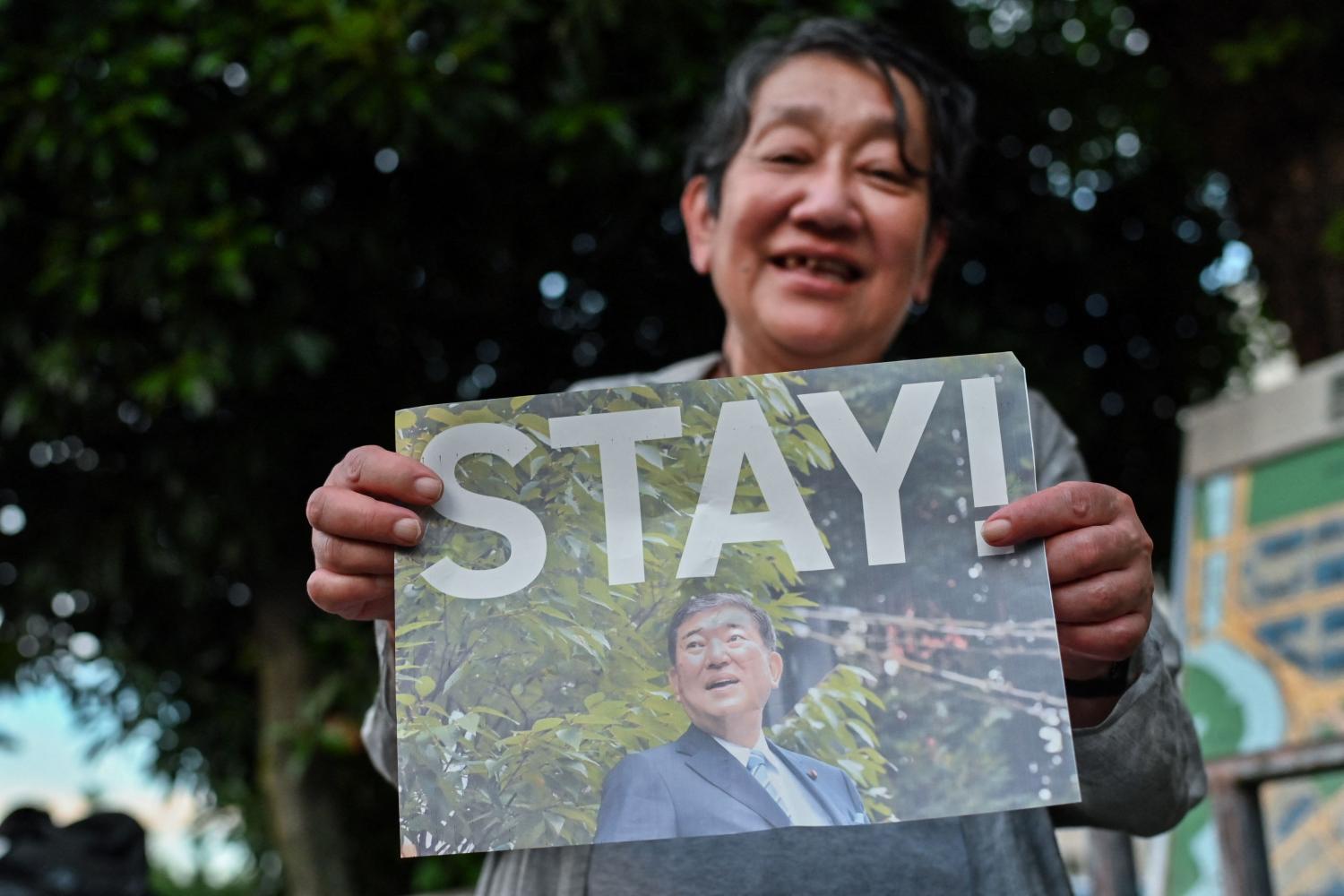A wave of political uncertainty is sweeping Japan as the resignation of Prime Minister Shigeru Ishiba threatens to redraw the country’s leadership map. With no clear winner emerging from the latest House of Councillors election and the ruling bloc losing its majority, analysts warn that Japan could face a period of sustained political turbulence. The Liberal Democratic Party (LDP) now confronts a crossroads: whether it can assemble a viable path forward from within its ranks or if it must forge new alliances to govern. The fallout from the elections — including losses in both chambers and a challenging domestic policy climate — underscores a broader shift in Japanese politics, where factions and strategic calculations are increasingly pivotal to any attempt to stabilize the government. The developments also raise questions about the viability of an opposition-led administration, given the ideological fragmentation that characterizes the opposition spectrum on key issues like national security and economic policy. As this political moment unfolds, the LDP’s next leader faces a delicate balancing act between appeasing a broad base and building new coalitions capable of passing critical legislation.
The Election Fallout: From Majority to Minority and the Broad Implications
The latest House of Councillors election produced a decisive setback for the ruling bloc, eroding the political ground that the LDP had long relied on to push through its policy agenda. In the wake of the results, the governing coalition found itself deprived of its majority in both houses—a rarity in recent Japanese political history. This shift complicates efforts to maintain a stable government and raises the possibility that the LDP will need to reassess its governance strategy, particularly in a political environment where public frustration over inflation and its impact on households remains a live issue. The loss of preexisting majorities forces the party to consider more complex parliamentary arithmetic, including the potential for cross-aisle cooperation or the negotiation of legislative concessions with opposition forces.
The political damage extended beyond procedural obstacles. The ruling bloc’s inability to translate electoral gains into sustained policy momentum has left it exposed to criticism over its handling of inflation and the economy. Domestic discontent, including the perception that the administration has not delivered effective relief measures for households, has played a significant role in eroding public trust. This context helps explain concurrent losses in other electoral arenas, such as the Tokyo metropolitan assembly election, which occurred in close temporal proximity to the upper house race. Analysts and insiders alike have linked these broader patterns of dissatisfaction to an impatience with policy inertia and a desire for more tangible reforms that address living costs and the social security framework. In this environment, the LDP’s capacity to rebuild credibility becomes a central strategic issue for any future leadership team.
The resignation scenario, namely Ishiba stepping down, further complicates the political calculus. With the party’s leadership transition looming, the question arises as to whether the LDP can field a prime minister who commands broad cross-party support or at least a workable majority, or whether it will need to seek allies outside its traditional coalition. The prospect of a no-confidence motion or a snap election hangs over the policymaking process, presenting both a risk and a potential reset for Japanese governance. In short, the election outcomes have inflicted a dual challenge: restoring parliamentary stability and sustaining public confidence in a government that has to navigate a more competitive domestic political landscape.
Amid these dynamics, the LDP may have to rethink its legislative strategy for the next term. Even if a leader can maintain the coalition’s core strength, the party will still need to secure backing from opposition groups to advance individual bills and budgets, at least until the next upper house election in three years. This reality underscores a broader trend in which party unity and cross-party negotiation become indispensable tools for governing in a highly factionalized political environment. As the LDP contemplates its options, the question of how to secure a functioning majority becomes central to any realistic expectation of governance, policy continuity, and reform.
Leadership Realignment Within the LDP: Potential Candidates and Strategic Shifts
The leadership succession following Ishiba’s potential exit is poised to redefine the LDP’s ideological direction. Within the party, several figures are touted as possible successors, each with distinct policy preferences and political profiles that could influence the party’s trajectory for years to come. One name that stands out in discussions is Sanae Takaichi, a former minister for economic security who has garnered strong support within the LDP in past leadership contests. Her track record includes a reputation for fiscal expansionism and a hawkish stance on national security, positioning her as a candidate who could push for bolder economic stimulus while maintaining a firm stance on security alliances. If elected, Takaichi would not only be set to become the party’s first female president but could also catalyze a realignment of conservative factions within the party.
Takaichi’s potential leadership could shift the party away from Ishiba’s more centrist or moderate posture, prompting concerns among some observers that a sharper rightward tilt might strain relationships with centrist and more moderate factions, as well as with long-standing coalition partner Komeito. This realignment could also have broader implications for Japan’s domestic and foreign policy posture, particularly in areas related to defense spending, constitutional interpretations, and regional security architecture. The prospect of a more aggressively fiscal stance, coupled with strong security commitments, may attract support from conservative voters but could provoke resistance from sectors of the political spectrum that prioritize social welfare and more cautious fiscal management.
Other figures in the discussion include Shinjiro Koizumi, the farm minister, who has reemerged on the national stage as a persuasive voice advocating for policies to curb surging rice prices and bolster agricultural resilience. Koizumi is viewed by some as a trusted ally of Ishiba, and his potential ascent could preserve continuity in certain policy lines while bringing renewed energy to coalition-building efforts. Koizumi’s stance and leadership style might reflect a pragmatic approach to governance, leveraging his visibility and policy focus to appeal to both rural constituencies and urban voters concerned about inflation and the cost of living.
On the broader horizon, former Prime Minister Fumio Kishida has not completely exited the political scene, even as he confronted criticism surrounding the erosion of conservative support that Shinzo Abe built prior to his 2022 assassination. Kishida’s political maneuvering remains a factor in shaping the post-Ishiba era, given that a reshaped LDP could still draw upon his experience and networks as it charts a new course. His possible return would carry implications for the party’s strategic alliances and its stance on security and economic policy, potentially attracting segments of the conservative base that seek a steady, experienced leadership style in times of volatility.
The potential leadership trajectory could also hinge on the party’s willingness to engage with outside actors and to recalibrate its coalition strategy. One plausible pathway involves strengthening ties with the Japan Innovation Party, which has demonstrated a capacity to pull in conservative and reform-minded groups. The willingness of Koizumi and other emerging leaders to collaborate with the Innovation Party could catalyze a broader realignment of Japan’s conservative landscape, affecting the feasibility of a grand coalition with the Constitutional Democratic Party of Japan or other opposition blocs. The ultimate outcome will depend on the capacity of the LDP to balance internal factional interests, secure a stable parliamentary majority, and build a cross-partisan consensus on key policy priorities.
In this climate, a critical question looms: can the LDP avoid a protracted leadership battle that destabilizes governance, or will it resort to a rapid, top-down decision to install a new president who can command a more unified mandate? The choice of leadership will shape not only policy directions but also how the party engages with opposition forces and how it communicates its economic and security agendas to voters across the political spectrum. If the LDP’s next leader opts for a more conservative, pro-spending stance, the party may aim to reassure supporters who favor robust fiscal stimulus, while attempting to mollify critics who are wary of deficits and debt levels. The path forward will require careful diplomacy, a calibrated public message, and a readiness to negotiate on a range of contentious issues, from tax policy to security arrangements.
Opposition Fragmentation and the Realities of Coalition Politics
The post-election landscape has left opposition forces with both an opportunity and a set of formidable challenges. While the loss of a governing majority opens space for a transition in leadership and potential policy shifts, the opposition remains ideologically fragmented, particularly on issues related to national security, defense policy, and the country’s broader strategic direction. This fragmentation complicates the prospect of a cohesive alternative government that can quickly unify the opposition around a single platform capable of appealing to a broad swath of voters. Analysts point out that even if the LDP-led coalition remains at the heart of governance, any future legislation will require at least some level of collaboration with opposition lawmakers to pass both budgets and policy measures, at least until the timing of the next major electoral milestone.
The existence of multiple opposition parties with divergent priorities means that any attempt to form a broad coalition would require delicate negotiations and concessions. The Constitutional Democratic Party of Japan (CDP) remains a key faction on the left, stressing different priorities on defense alliances, constitutional questions, and social welfare programs. However, the CDP’s approach to security and diplomacy could conflict with the more conservative leanings of other groups, complicating efforts to craft a unified platform capable of attracting centrist voters who are disillusioned with the incumbent government. In addition to the CDP, smaller but influential groups such as the Democratic Party for the People (DPP) and the right-leaning Sanseito party have gained momentum in various electoral contests. Their presence could act as kingmakers in any coalition talks, potentially enabling scenarios in which a broad cross-partisan government could form, albeit with a delicate balancing act to accommodate competing agendas.
The idea of a grand coalition, once a theoretical option, becomes more complex in this milieu. A grand coalition would require convergence on core security, economic, and social policy prescriptions that can command broad support. However, the largest opposition force tends to lean more left-leaning on security and diplomacy, making it less likely to align seamlessly with a center-right government unless compelling concessions are achieved. In this context, the role of minor conservative groups and populist factions becomes crucial. If these groups align with the LDP’s leadership, the coalition dynamics could shift in ways that either constrain or enable a broader governance framework. The possibility exists that some conservative opposition blocs, which gained momentum in recent elections, could coordinate with the LDP under a Takaichi-led or Koizumi-led governance framework, providing a pathway to a functional, if potentially uneasy, minority- or coalition-based government.
Yet even with potential coordination, a no-confidence motion looms as a tangible threat to government stability. Given the seat distribution in the lower house, such a motion could be expected to pass if the coalition cannot secure sufficient cross-party support. This possibility would likely precipitate formal moves toward dissolution of the lower house and the scheduling of snap elections, which in turn could trigger a broader realignment of political forces and alter the public’s assessment of leadership viability. Analysts warn that this sequence could extend political uncertainty for an extended period, affecting policy continuity and economic forecasts. The challenge for the opposition, therefore, is to present a credible, unifying platform that can win public support while contending with the LDP’s organizational strength and its long-standing network of political allies.
In light of these realities, the opposition’s path to power hinges on building strategic alliances beyond traditional party boundaries. A realignment that bridges left and right, and that also accommodates reform-minded conservatives, could potentially unlock new governance configurations. However, constructing such a coalition requires not only political capital but also a willingness to negotiate on divisive issues. The public’s appetite for compromise and pragmatic governance will play a critical role in determining whether any opposition-led administration can emerge and sustain itself during a period of macroeconomic volatility and shifting international dynamics.
Tax Policy and Social Security: The Consumption Tax Debate and Its Political Implications
A central policy fault line illuminated by the election results concerns the consumption tax and its role in financing social security and public services. Ishiba’s apparent reluctance to advocate for a reduction in the consumption tax rate, a move that critics contend would benefit households in the near term but could jeopardize social security funding, has become a flashpoint in the political debate. Some observers argue that the younger generation views this stance as tone-deaf to the real-world financial pressures facing households, a perception that could erode cross-generational support and widen ideological rifts within the LDP and beyond. The question of whether the LDP will initiate formal discussions on a consumption tax cut with opposition parties remains unresolved, with public sentiment pressing the party to articulate a clear, credible plan to shield vulnerable households while preserving the fiscal health of the social security system.
Within Takachiho University political science discourse, scholars like Ikuo Gonoi have highlighted a crucial public expectation: the electorate will not be satisfied unless the ruling party demonstrates meaningful concessions on the tax issue. This perspective underscores a broader theme in contemporary Japanese politics, where fiscal policy choices are inextricably linked to social welfare, demographic aging, and the fiscal sustainability of long-term programs. The fiscal challenge is acute: Japan’s aging population continues to place rising demands on healthcare, pensions, and long-term care, thereby increasing the urgency of sustainable funding mechanisms. Critics argue that any tax reform must be designed to balance intergenerational equity while preserving the government’s ability to invest in growth-oriented initiatives, infrastructure, and innovation. Proponents, however, contend that targeted tax relief or strategic spending can stimulate demand and alleviate the pressure felt by households, particularly those with lower incomes or precarious employment arrangements.
The political calculus around consumption tax is likely to shape the LDP’s post-Ishiba strategy. If the party aims to maintain a broad-based conservative coalition, it may opt for a cautious approach to tax cuts, tying concessions to demonstrable improvements in welfare, pensions, and healthcare services. Conversely, a more aggressive stance on fiscal stimulus, coupled with selective tax relief for families and workers, could be deployed to mobilize younger voters and the middle class, helping to broaden the party’s appeal beyond its traditional base. In either scenario, legislative progress will depend on the party’s ability to negotiate with opposition forces to craft a package that addresses both short-term relief and long-term fiscal stability. The debate thus becomes a focal point for the leadership’s broader strategy: can the LDP present a coherent policy package that resonates across generations while maintaining fiscal discipline and credibility in financial markets?
Inside the party, the dialogue about the consumption tax’s future may reveal fault lines between those who prioritize immediate relief and those who emphasize the need to safeguard social security. The outcome of these conversations will influence not only the next prime minister but also the composition of the party’s platform and its approach to coalition-building. The broader political community watches closely to see whether any concessions on tax policy can bridge divides and secure a workable parliamentary majority, or whether tax policy will remain a stubborn sticking point that complicates governance. In this sense, the consumption tax debate is less about a single policy question and more about the broader philosophy that will guide Japan’s fiscal policy for years to come.
International Trade and the Economic Context: The US-Japan Accord and Its Political Resonance
In the realm of international relations, the government’s handling of trade policy has become a weather vane for domestic political sentiment. A centerpiece of Ishiba’s government has been a trade agreement with the United States, which, according to pundits, has helped avert the most onerous potential outcome—a 25% reciprocal tariff that could have stifled Japan’s export sectors and weighed on growth. The deal’s completion is seen by some observers as a political achievement that could bolster Ishiba’s standing and provide leverage for his administration as it navigates internal challenges. However, the deal’s long-term political implications are more nuanced. While it may be framed as a success that anchors Japan’s strategic economic ties with the United States, it could also become a point of contention if future administrations re-open or renegotiate terms to accommodate evolving domestic priorities or changing geopolitical circumstances.
Pundits have suggested that the trade agreement’s resolution could serve as a catalyst for Ishiba’s departure, offering a narrative that he secured a significant international achievement while facing domestic political headwinds. The reality, of course, is more complex: trade policy is inherently a multi-stakeholder area, with businesses, labor groups, regional governments, and consumer interests all weighing in on the perceived costs and benefits of any deal. In this environment, the next LDP leader would need to manage a delicate balance between sustaining openness to global trade and addressing domestic concerns about job security, wage stagnation, and industrial competitiveness. The administration would also be compelled to articulate a coherent strategy for how trade policy aligns with broader economic goals, including inflation containment, investment in innovation, and the diversification of supply chains.
From a strategic standpoint, the United States remains a central ally and partner, and any future leadership must maintain a robust dialogue with Washington on security, energy, and technology cooperation. The broader geopolitics of the Asia-Pacific region, including tensions with other major powers and the need to manage alliance commitments, will continue to shape Japan’s policy choices. A leadership team that can articulate a clear, credible, and equitable trade and economic policy package will be well-positioned to garner support from key stakeholder groups, including manufacturers, exporters, and urban constituencies that have increasingly voiced concerns about inflation and the cost of living.
The Path Ahead: Parliamentary Dynamics, No-Confidence Motions, and Snap Elections
As Ishiba contemplates stepping aside or remaining in a leadership role, the legislative calendar will demand decisions about how to proceed with governance and reform. The political reality is that even if the LDP retains a core coalition, it will need to secure some level of cooperation from opposition parties to advance bills, pass budgets, and manage the day-to-day business of government. The risk of a no-confidence motion becomes a real political tool that opposition parties could deploy if they perceive that the leadership’s plan lacks legitimacy or broad public support. In such a scenario, the lower house could be dissolved, paving the way for snap elections that would reconfigure the political landscape and potentially redraw the balance of power in both houses.
Observers like Masamichi Adachi, the chief economist for Japan at UBS Securities, emphasize the uncertainty inherent in this period. He notes that political turbulence could endure regardless of the immediate electoral outcomes, given the structural challenges in coalition-building and the presence of dynamic, ideologically distinct opposition forces. This perspective underscores the fragility of any forward-looking governance plan and highlights the necessity for a leadership capable of building durable rhetorical and policy bridges across party lines. If a new LDP president does secure a stable union with non-traditional partners, the party could pursue a formal, negotiated platform that addresses core concerns while preserving the unity needed to pass essential policy measures. But if such consensus proves elusive, the political climate may continue to be unsettled, with markets and international partners watching the situation closely.
In examining potential outcomes, pundits weigh a few plausible scenarios. One path involves the LDP forming a more conservative, fiscally expansive leadership coalition that leans on a broader cross-party base to maintain governance. This would require careful negotiation with smaller parties and possibly the veteran coalition partner Komeito, along with a willingness to renegotiate policy stances to reflect the coalition’s broader spectrum. Another scenario envisions a more centrist or reform-oriented leadership that seeks to attract moderate opposition backing for key bills, including those related to social security, fiscal reform, and security policy. A third, more destabilizing path, involves a protracted period of political maneuvering, characterized by internal factional battles, shifting allegiances, and repeated calls for leadership changes that destabilize the government’s capacity to enact policy.
Ultimately, the choice of leadership and the way it handles coalition-building will determine the pace and direction of Japan’s policy agenda over the coming years. The new leader’s ability to articulate a coherent economic strategy, address inflation, safeguard social welfare, and respond to regional security challenges will be among the decisive factors shaping public support and investor confidence. The country watches for signals about how the administration will navigate these twin pressures: domestic demands for more effective governance and international expectations for stability in a rapidly changing geopolitical landscape.
Profiles in Focus: Potential Successors and Their Strategic Implications
Beyond Sanae Takaichi, Koizumi, and Kishida, several other figures loom in the background, shaping the speculative contours of Japan’s political future. Koizumi’s renewed visibility has reinforced his standing as a prototypical insider who could broker a workable coalition by leveraging his policy focus and media appeal. His alignment with Ishiba and with the broader conservative wing positions him as a potential caretaker of continuity, bridging factions that might otherwise diverge under a more radical leadership. Koizumi’s stance on rice price stabilization and agricultural policy has highlighted the importance of domestic production issues in a broad national strategy, signaling a pragmatic focus on sectoral resilience that can appeal to voters concerned about cost of living and supply chain reliability.
Yoshimasa Hayashi, as Chief Cabinet Secretary and a prominent government spokesperson, carries responsibility for communicating the administration’s policies and defending its record. His role in shaping the public narrative around the government’s performance makes him a potential candidate, particularly if the party seeks a leader who can articulate policy complexity with clarity and credibility. Yet Hayashi’s track record may also reflect vulnerabilities associated with the government’s broader performance, which could be a liability in a high-stakes leadership contest.
Former Prime Minister Kishida’s possible return remains a subject of interest among political observers. While Kishida has faced criticism for the perceived erosion of conservative support that Abe built, his experience in navigating complex political landscapes and his support base within the party could enable a re-entry with a refined strategy. Kishida’s candidacy would likely signal a return to a more traditional, cautious approach to policy and governance, appealing to voters who prioritize stability and a measured pace of reform. However, balancing the expectations of long-standing conservatives with those seeking institutional renewal would be a central challenge for any Kishida-led leadership.
Sanae Takaichi’s potential ascent could reshape the party’s approach to public spending and national security. Her demonstrated willingness to advocate for expansionary fiscal policies, coupled with a robust security posture, may help the LDP mobilize a broader support base that crosses traditional divides. The prospect of a Takaichi-led administration could catalyze a broader realignment among conservative groups, potentially altering the coalition’s dynamics and its approach to alliance-building beyond Komeito. The question will be how her leadership style and policy priorities align with the needs and expectations of different constituencies, including younger voters who are increasingly attuned to cost of living concerns and social welfare.
As the leadership race unfolds, it remains essential to monitor how the contenders balance internal party dynamics with the broader political landscape. The LDP’s choice will be judged not only on its ability to win support within the party but also on its capacity to secure cross-party backing for essential legislation. The party’s future depends on crafting a credible, coherent platform that resonates with the electorate and addresses the core issues of inflation, social welfare funding, national security, and Japan’s role in global economic governance. This balancing act will determine whether the LDP can maintain governance, adapt to evolving public expectations, and navigate the multipolar realities of international politics.
The Public, The Media Narrative, and the Youth Question
Public sentiment and media narratives will play a crucial role in shaping the political calculus in the months to come. The perception of Ishiba’s leadership and its impact on the economy has left a lasting impression on voters who are grappling with rising prices and financial stress. A key question for the future leadership is how to articulate a vision that reassures families and earnestly addresses the concerns of younger generations who feel disconnected from the benefits of the status quo. The younger generation’s response to tax policy, social security, and growth prospects will inform the type of leadership that can sustain support through a period of fiscal consolidation and social reform.
The media landscape will continue to influence public understanding of policy choices and the readiness of the electorate to accept compromise on contentious issues. A credible, consistent communication strategy that clarifies policy objectives, timelines, and expected outcomes will be essential for any leadership team seeking to stabilize governance. In addition to policy clarity, the narrative surrounding Japan’s international role—its alliance with the United States, its approach to regional security, and its engagement with global markets—will significantly affect public confidence. The ability of the leadership to present a coherent, forward-looking plan that is both grounded in fiscal prudence and ambitious in terms of growth and social welfare will be a decisive determinant of electoral endurance and political legitimacy.
Coalition Prospects: A New Architectural Vision for Japan’s Governance
New coalition dynamics could emerge if the LDP seeks to broaden its base beyond its traditional partners. The potential for a coalition that incorporates the Japan Innovation Party and other reform-oriented groups could offer a pathway to governance that blends fiscal discipline with pragmatic policy experimentation. The concept of a coalition involving right-leaning and centrist factions could provide the stability necessary to implement policy measures without falling into perpetual political deadlock. However, forming such an alliance would require substantial concessions, policy train-spotting, and a clear, credible shared agenda that can win broad public support.
In parallel, a potential alignment with the Democratic Party for the People or the Sanseito party could broaden the coalition’s appeal by incorporating populist and reformist voices. Such an arrangement would need to carefully calibrate policy positions on national security, social welfare, and regional development to avoid internal conflicts and to ensure coherence in legislative strategy. The prospect of a grand coalition, while challenging, remains a plausible scenario if the political climate shifts toward a more inclusive and reform-minded governance model. The fulcrum of any such arrangement will be the ability to unify diverse stakeholders around a compelling, workable agenda that can command trust across urban and rural constituencies alike.
The practical challenge remains: how to translate coalition ambitions into legislative actions that reflect the electorate’s priorities. The new leadership must cultivate not only party solidarity but also open communications with opposition lawmakers to enable timely passage of budgets and critical reforms. The success or failure of coalition negotiations will be judged by the ability to deliver tangible benefits to voters, including measures to curb inflation, protect social security, and strengthen Japan’s economic competitiveness in a volatile global economy. The future of governance therefore hinges on strategic negotiation, disciplined policy design, and a sustained commitment to bridging divides that have become more pronounced in recent times.
Conclusion
The political trajectory in Japan stands at a critical inflection point as Ishiba’s resignation impulse and the latest electoral outcomes reshape the coalition landscape. With the ruling bloc out of a clean majority, the LDP faces a pivotal decision: to pursue a leadership transition that can weld together a viable cross-party governance framework, or to double down on traditional coalition arrangements while seeking new alignments that reflect a shifting political reality. The opposition’s fragmented yet potent presence adds to the complexity of any post-election settlement, making coalition dynamics and policy negotiations the decisive arenas of the near term. Tax policy, social security funding, and the strategic posture in international trade will all be central themes that any leadership team must address with clarity and credibility. The prospects for stability depend on the capacity to forge credible compromises that reconcile competing visions, secure legislative approvals, and reassure both domestic voters and international partners that Japan’s governance can withstand rising economic and geopolitical pressures.
As the leadership contest unfolds, the next prime minister will bear the responsibility not only to manage the immediate parliamentary arithmetic but also to articulate a coherent long-term vision for Japan’s economy, security architecture, and social framework. The path to a stable government may require a deft blend of fiscal prudence, targeted spending, and strategic diplomacy—an approach that can win broad-based support while preserving the country’s strategic interests on the world stage. Whether Ishiba remains a central figure, whether Takaichi becomes the party’s first female president, or whether Koizumi, Kishida, or Hayashi leads the LDP into a new era, the core challenge will be to translate political shifts into concrete improvements in people’s lives. The coming months will reveal whether Japan can navigate through this period of volatility with resilient governance and a renewed sense of public trust, or whether the nation will drift into an extended phase of political uncertainty that tests the durability of its institutions and the endurance of its democratic processes.





